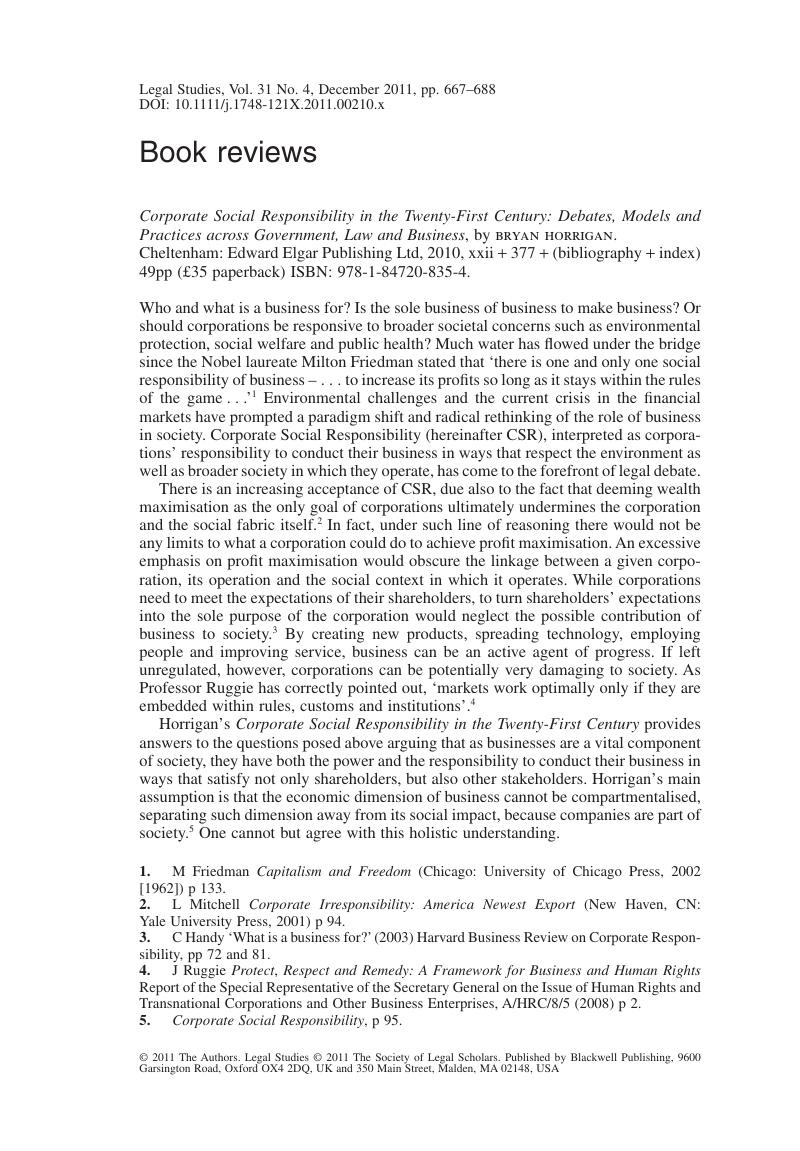No CrossRef data available.
Published online by Cambridge University Press: 02 January 2018

1 Friedman, M Capitalism and Freedom (Chicago: University of Chicago Press, 2002 1962) p 133 Google Scholar.
2 Mitchell, L Corporate Irresponsibility: America Newest Export (New Haven, CN: Yale University Press, 2001) p 94 Google Scholar.
3 C Handy ‘What is a business for?’ (2003) Harvard Business Review on Corporate Responsibility, pp 72 and 81.
4 J Ruggie Protect, Respect and Remedy: A Framework for Business and Human Rights Report of the Special Representative of the Secretary General on the Issue of Human Rights and Transnational Corporations and Other Business Enterprises, A/HRC/8/5 (2008) p 2.
5 Corporate Social Responsibility, p 95.
6 Ibid, p 34.
7 Ibid, p 20.
8 Ibid, p 21.
9 Reich, R Supercapitalism: The Transformation of Business, Democracy and Everyday Life (New York: Alfred A Knopf, 2007) pp 204–205, 214Google Scholar.
10 Corporate Social Responsibility, p 21.
11 Ibid, p 36.
12 Ibid, p 39.
13 Ibid, p 131.
14 J Eijsbout ‘Corporate social responsibility and law’ 5 Ouranostra 2 at 49.
15 People, Planet and Profit (Triple P) or Triple Bottom Line (TBL) refers to economic prosperity (profit), environmental quality (planet) and social justice (people).
16 Ibid, at 50.
17 For instance, in a number of jurisdictions, corporate law requires directors to consider employee, and other community interests in their decision making. Corporate Social Responsibility, pp 182–183, 199 (referring to the UK Companies Act 2006). Mandatory corporate reporting of environmental compliance and impact is now a standard feature of many corporate regulatory regimes. Ibid, p 185.
18 Regulatory incentives include tax reductions, preferential treatment in public procurement, award schemes, tradable emissions permits etc. Ibid, p 157.
19 Ibid, p 26.
20 Ibid, p 87.
21 Ibid, p 172.
22 Ibid, p 169.
23 Ibid, p 172.
24 The framework is based on three pillars: 1) the state duty to protect human rights; 2) the corporate duty to respect human rights; and 3) the need for access to effective remedies where abuses occur. See above n 4.
25 Corporate Social Responsibility, p 308.
26 J Moon, A Crane and D Matten ‘Can corporations be citizens? Corporate citizenship as a metaphor for business participation in society’ 15 Business Ethics Quarterly 3 at 427–451.
27 Corporate Social Responsibility, p ix.
28 Ibid, p xii.
29 On the interplay between CSR and international investment law and arbitration, see Muchlinski, P ‘Corporate social responsibility’ in Muchlinski, P, Ortino, F and Schreuer, C (eds) The Oxford Handbook of International Investment Law (Oxford: OUP, 2008) pp 637–687, 683Google Scholar; Muchlinski, P ‘Caveat investor? the relevance of the conduct of the investor under the fair and equitable treatment standard’ (2006) 55 ICLQ 527 Google Scholar.